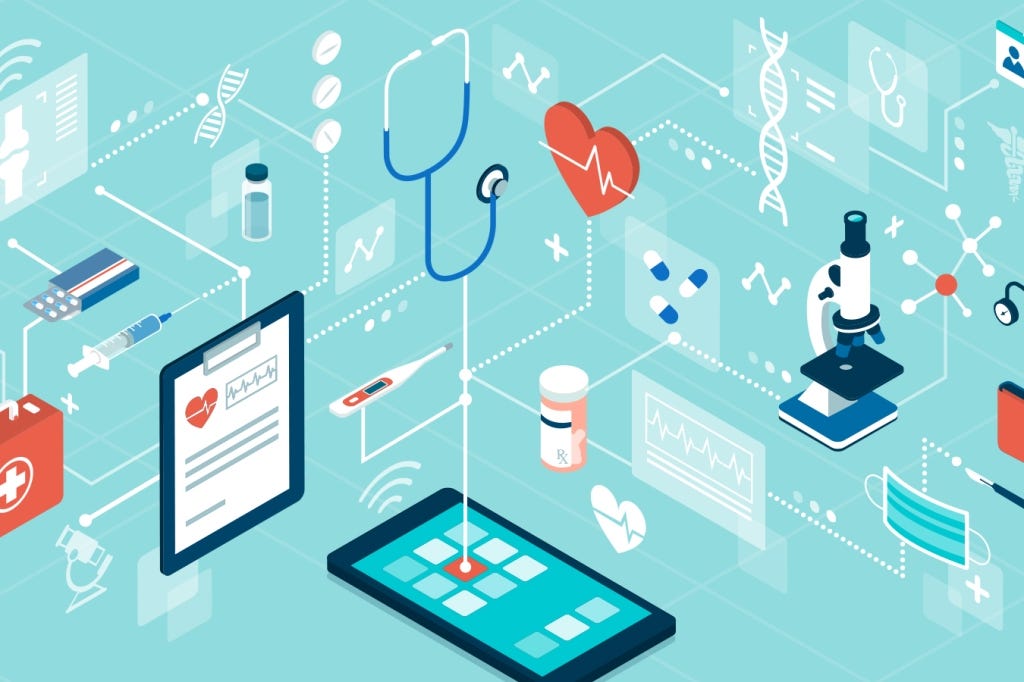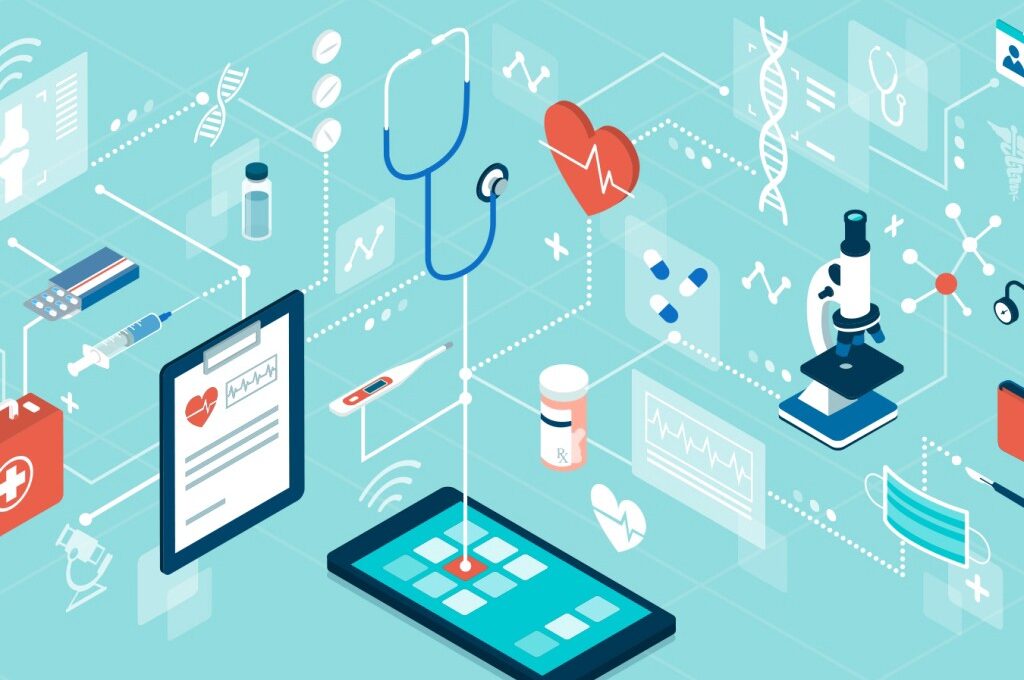Site editor:
Joaquim Cardoso MSc
The Health Strategist — for continuous health transformation
September 23, 2022 (khn)
The Permanente Journal
Christina Sze, MD, Vahan Simonyan, PhD, Art Sedrakyan, MD, and Bilal Chughtai, MD
July 20, 2022
KEY MESSAGE:
- Mobile applications along with a virtual cloud environment to host data provide a reasonable solution for consolidating patient data and can accelerate population research.
ABSTRACT
Introduction
- Data extraction from electronic health records (EHRs) for use in clinical research continues to be labor-intensive and to offer little benefit over traditional paper chart reviews.
- This is largely due to poor integration of EHR systems with hospital process flow, which still relies heavily on traditional paperwork as a means of documentation.
Discussion
- New methods in data collection through mobile applications have streamlined data entry through better data standardization and improved overall data quality.
- However, mobile applications address only a portion of the problem.
- Data entry errors and legacy integration will continue to be an issue when there are changes between practitioners with different EHR systems.
- The combination of a mobile application with the cloud platform has been applied in multiple specialties to monitor recovery and patient-reported outcomes.
Conclusion
- Mobile applications along with a virtual cloud environment to host data provide a reasonable solution for consolidating patient data and can accelerate population research.
Mobile applications along with a virtual cloud environment to host data provide a reasonable solution for consolidating patient data and can accelerate population research.
ORIGINAL PUBLICATION (full version)

Introduction
Health care systems in the United States have embraced the digital revolution and largely abandoned paper-based health care records.
Based on the 2019 National Electronic Health Records (EHR) Survey,
- almost 90% of office-based physicians have adopted EHR systems, and
- 96% of nonfederal acute care hospitals have used a certified EHR system.1
This transformation was at least partially facilitated by the 21st Century Cures Act, passed in 2016.2
The Cures Act promoted the use of EHRs by mandating that all health care practitioners provide clinical notes in digital formats to patients.2
Based on the 2019 National Electronic Health Records (EHR) Survey: (1) almost 90% of office-based physicians have adopted EHR systems, and (2) 96% of nonfederal acute care hospitals have used a certified EHR system.
The Cures Act promoted the use of EHRs by mandating that all health care practitioners provide clinical notes in digital formats to patients.

However, data extraction from EHR systems for research use continues to be labor-intensive and to require the same manual chart review …
… because the majority of patient-reported outcome measures and clinical-related questionnaires are typically scanned into the chart and are not available in parsed fields.
Manual data extraction is error-prone and time-consuming, which poses a substantial problem in clinical research.
Manual data extraction is error-prone and time-consuming, which poses a substantial problem in clinical research.
Wahi et al. analyzed the manual transcription error rates for questionnaires from 93 participants, and the overall error rates they found were surprisingly high (270 per 10,000 fields) despite the use of a second data manager to verify the work [2,7%] .3
Extensive and costly validation procedures are required to ensure that data is accurate, consistent, and reliable.
From a clinical and research perspective, questionnaires are essential to track treatment response and assess patients’ quality of life and overall function; however, they are still often administered in paper form.
Extraction of data from these scanned images is a manually intensive process that can often lead to transcription errors, compromising the integrity of a study.
Adoption of EHRs has not sufficiently advanced the infrastructure for conducting research on scanned questionnaires, and therefore, we propose an innovative solution for outcome research based on patient-reported outcome measures combining the use of mobile technologies and a virtual cloud system
Adoption of EHRs has not sufficiently advanced the infrastructure for conducting research on scanned questionnaires, and therefore, …
… we propose an innovative solution for outcome research based on patient-reported outcome measures combining the use of mobile technologies and a virtual cloud system

Data collection software through a mobile application (app) is a cost-effective long-term solution …
… that can be utilized to directly collect a patient’s entry, thereby minimizing data migration errors and reducing resources required to train individuals for data entry and data quality management. Mobile apps have been demonstrated to increase adherence to treatment regimes, reduce unnecessary health service utilization, and facilitate the entry of validated questionnaires used to assess treatment response.4,5

However, mobile apps address only a portion of the problem.
Data integrity, quality, and legacy integration will continue to be issues when there are changes between practitioners who use different EHR systems.
The solution is an externally managed repository and universal standard set by the federal government that can bridge systems.
Currently, there are several state and local public health agencies that support data exchange.
However, it is unclear how often they are kept up to date and how much variability exists in how accessible this information is to patients and health care practitioners given that the implementation changes from state to state.6
Therefore, a virtual cloud environment supported by the federal government that is capable of real-time updates will reduce the need for physical storage and designated data managers.
Therefore, a virtual cloud environment supported by the federal government that is capable of real-time updates will reduce the need for physical storage and designated data managers.
One example of this type of virtual system that creates a unique and trusted collaborative environment is the High-performance Integrated Virtual Environment (HIVE).
This is a cloud computing system created and originally optimized for the storage and analysis of large amounts of data such as next-generation sequencing data.
However, with the addition of new and innovative tools, this virtual cloud is ideal for clinical research and the creation of large clinical data sets.7
The security system implements a high-security hierarchical control system that ensures privacy and integrity of the retrieved data and is compliant with Health Insurance Portability and Accountability Act.8
Mobile applications executed on the cloud encouraged a patient medical questionnaire completion rate of 95%, significantly higher than for other mobile applications (30%-84%) that were locally hosted.9,10
Mobile applications executed on the cloud encouraged a patient medical questionnaire completion rate of 95%, significantly higher than for other mobile applications (30%-84%) that were locally hosted.
The combination of a mobile application with the cloud platform has been applied in multiple specialties …
We previously leveraged the HIVE infrastructure to implement and facilitate a mobile application to host questionnaires for stress urinary incontinence with reported high satisfaction from patients and surgeons (60% and 80%, respectively).5
The combination of a mobile application with the cloud platform has been applied in multiple specialties, including maxillofacial and oral surgery as a tool for conducting cross-sectional studies between chronic temporomandibular disorders and asymptomatic individuals,11as well as after a prostatectomy to monitor recovery and patient-reported outcomes.12

A virtual cloud environment creates a trusted environment for the interaction of patients and clinicians interested in research.
This collaborative environment mitigates the challenge of monitoring data that requires long-term follow-up such as symptom scores to assess the efficacy of a treatment or the need for re-treatment.
The use of mobile apps along with a virtual cloud environment to host the data can reduce resource requirements for research data entry.
This collaborative environment mitigates the challenge of monitoring data that requires long-term follow-up such as symptom scores to assess the efficacy of a treatment or the need for re-treatment.
The use of mobile apps along with a virtual cloud environment to host the data can reduce resource requirements for research data entry.
There is currently a response to move to a single, centralized repository of clinical content that can store health care data, thereby reducing administration and maintenance costs.
Mobile apps combined with a virtual cloud environment to host the data provide a reasonable solution for consolidating patient data and can accelerate population research.
Mobile apps combined with a virtual cloud environment to host the data provide a reasonable solution for consolidating patient data and can accelerate population research.
Originally published at https://www.thepermanentejournal.org.
Authors and Affiliations
Christina Sze, MD,
Vahan Simonyan, PhD,
Art Sedrakyan, MD, and
Bilal Chughtai, MD
1 Department of Urology,
Weill Cornell Medical College / New York Presbyterian, New York, NY, USA
2 Center for Biologics Evaluation and Research,
U.S. Food and Drug Administration, Silver Spring, MD, USA
3 Department of Healthcare Policy and Research,
Weill Cornell Medical College – New York Presbyterian, New York, NY, USA












